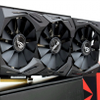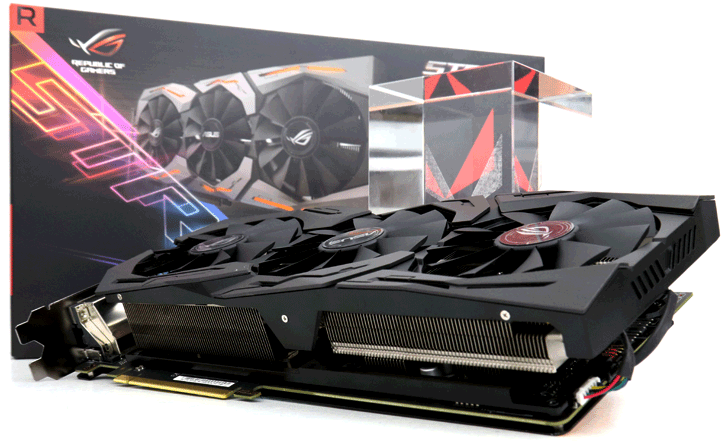Final words and conclusion
Conclusion
It's been an interesting ride for and with AMD Radeon RX Vega. Pretty much what I have mentioned in the reference reviews is that Vega 56 and 64 are both good and nice products, the reference air-cooled versions run loud and rather hot though. I also stated that things would get far more interesting with AIB cards that are customized in PCB design and cooling. On that front ASUS delivers a nice appealing product sometimes a frame faster, sometimes a frame slower compared to the reference card. The next register to check is performance. Hey it's good perf for the year 2017, but it is the equivalent of the reference 1080 performance wise that got released in 2016. Now there's nothing wrong with that, as long as the price and generic variables remain right. And pricing might be the biggest culprit of this release. Due to limited availability Vega is pretty hard to get, and likely due to HBM2 hard to fab. Recent suggestions indicated it will take up-to October until there is better volume availability of these GPUs, and then when the market is low in availability, prices remain high. The team green GTX 1080 card sits at prices around and above 500 USD/Euro, the Vega 64 sits (or should be sitting) just under that price threshold. Then another fact you will need to weigh in, that 1080 is available in more advanced factory tweaked models offering an extra 10% perf straight out of the box. Testing this Vega 64 overall though, well it has been a pleasure. The card does perform nicely with games anno 2017 and does position itself in a very competitive performance bracket. We had little issues with the card really, though sometimes you can stumble into an oddity like we noticed the perf is way worse (GTA5) compared to the GTX 1080, but then again excellent with, say, Battlefield 1. Yep, there will be some anomalies, however driver support from team red has greatly improved over the past year or two. It'll all be addressed. One note I'd like to add is that I am fairly fascinated by the new HBCC feature. Much like 10 years ago with Turbocache (Nv) or Hypermemory (ATi) you can add an extra cache / memory pool or swap-file if you wish and assign it to the GPU to use at its disposal (at the cost of RAM memory). This implementation is a sound one, which so much more volume and bandwidth anno 2017 on your system memory available If you have plenty of system memory, this can benefit games in the long run with extensive high quality textures etc. Currently the benefits do not show up though, but I am very excited to see this new feature. Time will tell, but there is good potential in the Vega chip alright.
The Vega GPU & performance
Vega performs nicely and sure does look sexy with the two HMB2 stacks on that single Godzilla sized chip. The end result is a chip that has close to 12 Billion transistors on the GPU (that's excluding HBM I think), and that is fairly massive, a chip sized 512 mm²; imagine that for a 14nm graphics processor. Despite its size, AMD also managed to keep power consumption reasonably under control though it seems to pass the 300 Watt marker when stressed. The Vega 64 air-cooled edition is a good notch faster than the RX 580 8GB and the Fury series. It is good to see we left the 4 GB VRAM cards behind us as I feel 8 GB is the current sweet spot for modern age PC gaming, the way it's meant to be played (no pun intended). In its reference performance bracket the card is a good choice for 1080p, 1440p as well as 3840x2160 gaming. And, well, let's be brutally honest here, for the 499 USD price tag, it needs to be a card that can deal with 3840x2160. I am however very interested to see what the liquid cooled version will offer with its higher clocks, as well as board partner cards with proper cooling. See, there is more performance to be found in that GPU at a 1.65 GHz boost range. So yes, i am excited to test more of these puppies. That is the same for the Vega 56 model, which might hit a certain sweet-spot compared to the GeForce GTX 1070. But I can only make objective comments on that once we actually have had that card at hand to test. Vega 64 has the potential to be a bit of a beast, but needs the right circumstances to really shine. We think a driver tweak or two is still in order. The Radeon RX Vega 64, in most scenarios (depending on the game / render intensity / resolution), will perform close to the GeForce GTX 1080, with the usual and unusual exceptions here and there. And then once Ultra HD kicks in, things equalize or get better real fast at very acceptable framerates. Typically in Ultra HD you are bound to run out of graphics memory fairly fast, here's where that 8 GB kicks in nicely. Remember though, most of the data that resides in the framebuffer is cached data, that prevents things like swapping files from your HDD/SSD. Not all cached data is used and, in most scenarios, when you run out of graphics memory it just doesn't matter. It does start to matter when you have Ultra HD texture packs and weird AA modes. If you want 8x MSAA at Ultra HD, we assume that 8 GB will still not be enough. Fool around a bit with the HBCC options, and you can use your system memory as an extra memory pool / buffer. HBM2 does offer very low latency graphics memory with nice bandwidth. But hey, performance wise really there's not one game that won't run seriously good at WQHD and even Ultra HD and that remains a fact. Vega definitely can crunch and render them games.
Pricing
Value wise the Radeon RX Vega 64 is making sense, but likely should have been 50 bucks cheaper. When compared to the rest of the the market that would make sense. However, at launch there will not (likely) be a lot of volume available, and with the ongoing mining craze these cards will sell regardless of the 499 USD pricetag. So let me reiterate pricing, Vega 56 will cost 399, Vega 64 499 USD (the standalone air-cooled versions). The liquid cooled edition that is clocked faster will sell at a price of 699 USD. We'll leave out the bundling stuff for now, as it is merely confusing and we doubt that many people are actually interested in the discount bundles where you need to purchase a specific monitor and Ryzen processor. Then the AIB partners versus pricing, I dunno. This card could be a tenner more expensive, it could be a hundred bucks. I do know however that a card like the Vega 64 STRIX would not make much sense once you pass that 500~550 EURO region.
Cooling & noise Levels
The regular Vega is an air based single spinner cooler product series. The end result for Vega 64 reference is a product package that keeps the graphics processor at a maximum of ~80 degrees C, and that works okay but was too loud for my taste. With the STRIX you get the benefit of the three fan cooler. The card hovers in that 75~78 Degrees C range cooling wise under heavy stress. It was a little higher then expected with such a massive cooler though. The card is a notch more silent under stress compared to the reference air-cooled version, but here again isn't getting the label silent. At the silent BIOS mode things are more normal (but at the cost of performance). We'd rate the product noise levels as moderate under heavy GPU load in its default configuration.
Power consumption
Overall power consumption is without doubt spicy, the reference cards are rated as having a 295 Watt TDP, depending on the workload. We measure numbers in the 320 Watt range (peak) with gaming on the STRIX. That number varies a bit per game title and resolution of course. It's a really substantial wattage, especially compared to the competitions product in the same performance bracket. Interestingly enough, it was a notch lower compared to what we measured with the reference card.
Overclocking
The card can be overclocked, not heaps though. You will need Wattman or an AIB tweaking tool. For Wattman we feel the interface is becoming too big and annoying IMHO. The most benefit from tweaking on air-based cooling is increasing the power limiter and the core clock frequency. once you tweak these two registers your card should stick at 1600 MHz without throttling. If you can increase cooling performance, 1700 MHz is possible. Ergo we feel that Vega 64 really is better off with liquid cooling. It is a tricky to tweak product, limiters will kick in at some point downclocking the GPU clock.
Final words
You know, I keep thinking, what if. What if AMD had Vega ready like a year ago, battling the GTX 1080. I think it would have been received completely different. People most likely do not frown that much upon the higher power consumption, the performance is there. Where the reference air-cooled cards are simply stated, noisy a custom card like the STRIX could change the and that dynamic a bit. This card however is not silent, but silent enough which filters away that extensive concern of mine. Performance wise VEGA 64 STRIX is showing nice yet close to reference numbers. Sometimes a bit more, in others a little less depending on throttling and register variables. With the 8 GB of graphics memory you can game at 2560x1440 really well for a fair amount of money (if you can pick one up at normal prices of course). And hey, it doesn't disappoint in Ultra HD either. There is very little wrong with this GPU overall but granted though, the Vega cards, however, are not a serial game killers right now as it's all a bit average sitting in a performance bracket that the competition offers for the same amount of money for a year now, the GeForce GTX 1080. That, however, is an okay performance bracket to be in, let's be honest here as that is a performance level as that offers a terrific PC gaming experience at say 2560x1440. We do hope to see some driver tweaks that will lift up game performance in the Full HD to WHQD domain a bit more, we still see a bit of CPU overhead with AMD drivers, and that shows at 1920x1080 (it's all very relative though). The brutal truth is that being as close to the reference GTX 1080 Ti really is what this release was in everybody's expectations. If you plan to go for an Ultra HD build, then the Radeon Vega 64 could be a nice match alright. Just connect it to a FreeSync monitor and you'll have a proper gaming experience. ASUS did as much as they could with Vega 64, but that big GPU seems to be a beast to tame on air alright. With this huge cooler the card remains cool-ish (is that even a word?) enough but not by an extensive margin, but it certainly cools better than what the reference products offer. And hey, it is a bit more silent as well. That is a nice improvement overall. Pricing remains trivial, purely based on performance this card cannot exceed the 500~550 Euro pricing bracket as behind that number it just doesn't make sense. But if priced right once volume availability kicks in, we could surely recommend the Radeon RX Vega 64 STRIX over the reference cards - if it fits your budget and brand preference, specifically for the Vega 64. In the end though, the Vega 56 models will make more sense pricing wise relative to performance. But for Vega 64, this might be as good as it is going to get.
Let us know what you thnk about this product in this forum thread.
** September 25th 2017 - Please read **
A day after initial publication and sharing our results/review ASUS of this article asked us to take the review down. The story at the time was that they shipped the card to us with the wrong BIOS. We've been eagerly awaiting the new BIOS for two weeks now, but nothing is coming from ASUS. ASUS did present a specific driver on their website, we tried it yet it is based on the 17.7 driver series which (obviously) did not make an improvement either.Ergo, we are re-publishing the results as-as. I do want make a side-note on temps and noise levels. After we disassembled the card for a photo-shoot, we reassembled it and obviously applied new thermal paste on the GPU. This shaved off 3 degrees 3 in heavy load conditions. That three degrees is significant as at that stage the card is more silent as well. That said, we are publishing the results as-is. When you purchase a product as your average end-user, you're not likely going to swap out TIM as it breaks warranty. But for those daring enough and interested in this card, it might be a nice tip. ASUS states that the STRIX has a more extensive power limiter and should be faster, however we state that the thermals are throttling the card down rendering the extra power limiter fairly inoperable.
Should ASUS come up with a new BIOS (which we doubt) we'll update the test results.
Recommended Downloads
- Unigine Heaven Stress test
- MSI AfterBurner
- 3DMark FireStrike + Time Spy (2016)
- Download AMD Radeon drivers
- Download GeForce drivers
Sign up to receive a notice when we publish a new article
Or go back to Guru3D's front page
- “You Know Nothing, Jon Snow Aegon Targaryen”



